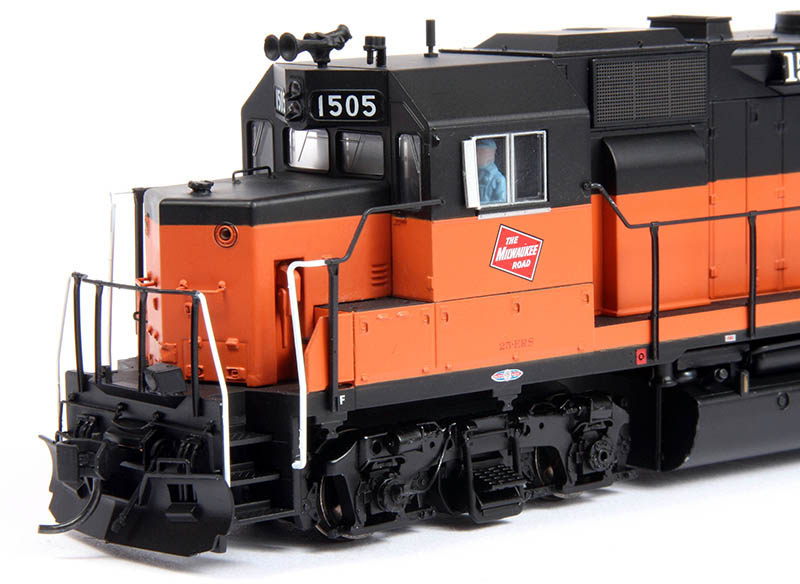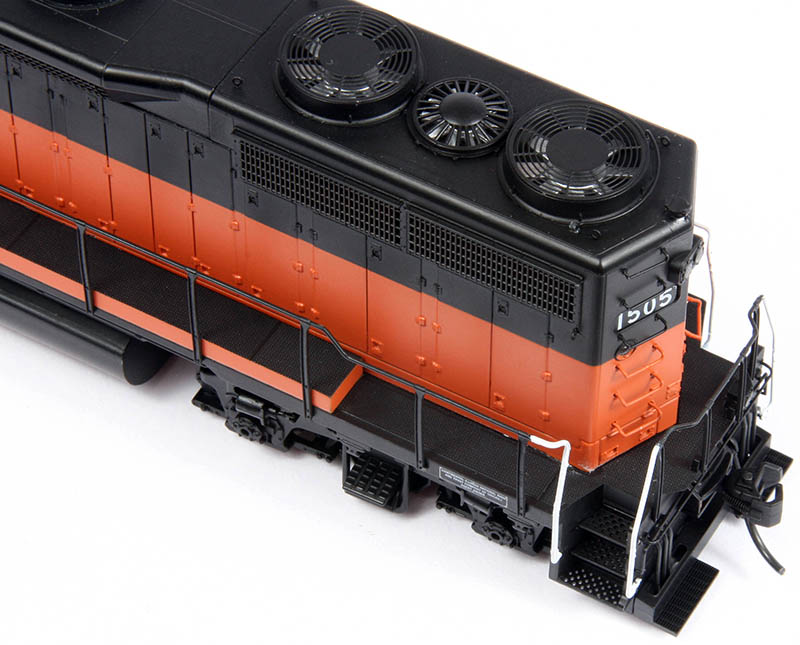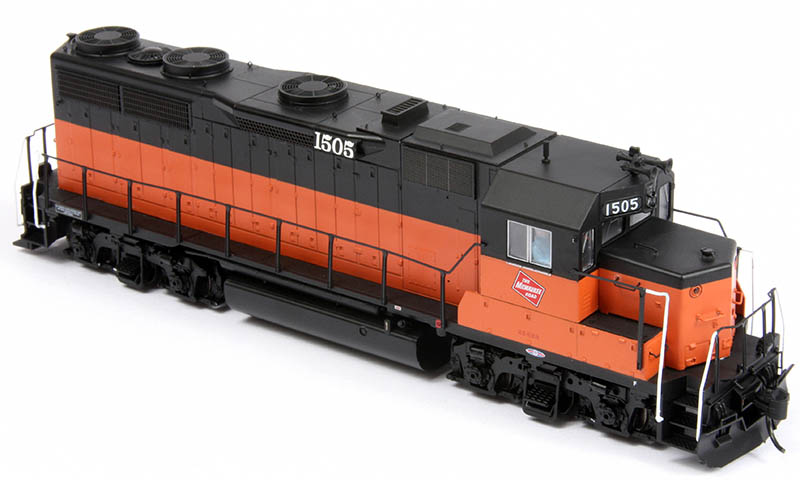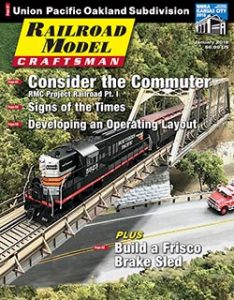 Review by David Otte/photos by the author
Review by David Otte/photos by the author
As important as the GP35 was to Electro-Motive Division’s motive power lineup in the mid 1960s, it’s surprising that HO scale modelers have had to wait as long as they have for a high-end road specific rendering of this second generation diesel. Nevertheless, Walthers’ new Proto edition Phase II GP35 is a welcomed sight indeed and brings to the table the potential for numerous ready-to-roll versions of this 2500 horsepower transitional locomotive on an owner by owner basis.
For its initial release, the company is offering both Standard Direct Current (MSRP $199.98) and Digital Command Control/Sound equipped (MSRP $299.98) models decorated for Burlington Northern, Chesapeake & Ohio, Erie Lackawanna, Milwaukee Road, Santa Fe and Southern Pacific plus undecorated with each paint scheme available in multiple limited edition road numbers, as appropriate. Furthermore, additional new roadnames announced for a planned fourth quarter 2017 release include: Chessie System, Conrail, Gulf Mobile & Ohio, and Rock Island, along with new paint/roadnumbers for Santa Fe and SP.
So why all the excitement over yet another model of an EMD Geep, you ask? Well, I’ll let the locomotive’s history speak for itself. When General Electric debuted its 2500 horsepower U25B diesel-electric in 1960, the locomotive building industry was turned upside down. The 4-axle high horsepower unit offered such cutting edge technologies as a sealed carbody, a filtered centralized air intake system, and an equipment layout designed for ease of maintenance. Two U25Bs could do the job of three first generation diesels. Although not fully up to the new standards set by the U-boat, Alco had also entered the fray with the release of its 2400 horsepower RS-27 the year before.
As a result, EMD, wishing to retain its number one spot in dieseldom, was forced to scramble its design department to meet the new high horsepower challenge, which arrived in the form of the GP30 in 1962. EMD, however, had come to the racetrack with only 2250 horsepower under the hood of its latest Geep and, as this three-way competition for the second-generation diesel market unfolded, the GE unit’s extra 250 horsepower continued to help move the company up to the number two spot in the production of locomotives – leaving Alco behind never to recover.

Fearing GE’s further advancement, EMD went back to the drawing board and shortly thereafter unveiled its new GP35 at the American Railway Progress Exposition in October 1963. Generally a makeover of its GP30, the new model offered a horsepower of 2500 – meeting the competition face to face. Responsible for the new surge in power was a redesign of EMD’s faithful 567 prime mover, which dated back to the F-units and early GP7 – the first Geep (the GP35 would be the last EMD road locomotive to used this engine). Designated the 567D3A, the engineers at LaGrange made changes to the 16 cylinder 567’s pistons, cylinder head, and turbo charger while also improving the air filtration and electrical system. External changes, as compared to the GP30, included a simplified, but still sealed carbody with a squared off and angular cab (known as the Spartan Cab), which has been used by EMD in one form or another up until the emergence of the safety cab design.
The GP35 is easily identifiable from other later EMD angled cab units by the unique cooling fan arrangement on the rear of the long hood – two 48-inch diameter fans with a 36-inch fan in between. With a 260,000 pound average weight and equipped with four EMD D67 traction motors, a model D32 generator, and a D14 alternator, these 2500 horsepower units had a starting tractive effort of 60,500 pounds and continuous tractive effort of 50,000 pounds.
For further referencing GP35 production, railfans have determined the locomotive was built in two distinct phases with some additional noteworthy minor sub variations. Generally speaking, though, the Phase I GP35 was built on the same frame design as its predecessor, the GP30, which actually dates back to the GP7. The resulting thicker appearing side sill arrangement constituted 77 percent of the total GP35 production. The minority Phase II units, on the other hand, were built on a new platform with a thinner side frame, as utilized on the later 3000 horsepower GP40 model and subsequent production 4-axle units. So, to a degree, the GP35 stands as a true EMD transitional design locomotive representing what has been and what was to come down the road in the category of 4-axle high horsepower units.
EMD’s timing of the introduction of the GP35 seemed to be just right too, as a massive retirement of first generation locomotives was then underway, and, just like an automobile dealership, railroads began trading in their worn out cab units and road switchers for shiny new GP35s. EMD would produce a total of 1,333 units between 1963 and 1966, putting the company far out in the lead over its competitor’s measly 478 U25B sales. Some 41 different railroads purchased the GP35, including Canadian and Mexican customers, with the Santa Fe (161 units), Southern Pacific (160 units), and the Pennsylvania Railroad (119 units) being the three largest buyers. Many GP35s are still in service today through second hand owners while Class I Burlington Northern Santa Fe continues to roster a sizeable fleet of inherited GP35s, albeit heavily rebuilt.

While initially the old Athearn and later the Kato HO scale GP35 models have provided hobbyists with examples of this prototype, these samples of mid to late 20th century tooling only represented Phase I production of this Geep, so the new WalthersProto Phase II offering is doubly welcome (as is the hope that a Phase I version isn’t too far off on the horizon as well).
As we have come to expect from the Proto lineup, the 1:87 Geep is generally an accurately dimensioned ready-to-run rendering that exhibits the usual array of crisp molded-in details and, of course, a whole host of wonderful separately applied parts, which, on this particular release, are all factory applied and ready to be enjoyed by the operator and collector alike. Perhaps the first attributes the GP35 fan’s longing eyes are directed to, though, are the telltale signs of the Phase II design, so we’ll begin there.
To start with, the initial Phase IIa GP35s that rolled off the assembly line in April 1965 retained a number of characteristics of Phase 1c production units, most notably multi-latch engine compartment doors, multi-wire constructed radiator intake grilles, a 36 inch diameter flat-topped radiator cooling fan, flat screen covered inertial air intake grilles, single louver sets on the battery box doors, and a flat inertial air filter hatch on the roof – all the while displaying the new thinner side sills and a fuel tank that now boasted a sloped-top design rather than the old flat-topped tank. By May of that same year, though, EMD had adjusted the inertial air filter hatch to be a raised design, the Phase IIb model, while in the ensuing months and up until the end of production in December 1965 the builder resorted to re-using the older style 36 inch domed-top center radiator cooling fans, now becoming abundant from the multitude of first generation EMD trade-ins, along with a new corrugated style inertial air intake grille – Phase IIc.
Even though the Walthers’ HO scale model can potentially cover all three sub phases, we’ll focus only on our particular sample for this review – Milwaukee Road 1505. A group of 12 GP35s was purchased by the MR and delivered in May and June 1965. Originally numbered 360 – 371, the units were renumbered 1500 – 1511 in 1968. Designated internally as “25-ERS” for 2500 horsepower EMD Road Switcher, the black and orange painted Geeps featured 2600 gallon fuel tanks, dynamic brakes, extra jack pads (total of 8), side numberboards attached to the front section of dynamic brake housing, front snow plow, and the road’s signature electronic bell mounted on the cab roof. The locomotives continued on the roster through the Milwaukee Road’s merger into the Soo Line in 1986.
The accompanying side view shot of the 1:87 rendering quickly verifies the presents of the appropriate thin side sill of the prototype’s new frame design and accompanying slopped-top fuel tank as well as those identifying features carried over from the Phase Ic Geeps. However, with MR 1505 having been erected in May 1965, the new raised inertial air filter hatch is also appropriately present on the miniature locomotive. Another detail found on both the model and the real deal is a domed-top center radiator cooling fan while at the same time maintaining the older style flat screen inertial air intake grilles – suggesting a Phase IIb variant.
Noteworthy also are the other nuances of this new WalthersProto offering, as visible in the balance of the photos: wire formed grab irons on the hood ends and rooftop lift rings; durable but delicate looking plastic side and end railing; frame steps with see-through treads; multiple unit (MU) and trainline air hoses on the pilots with MU electrical receptacles located above on the end platform decks; air reservoir tanks and piping; see-through cooling fans with separate blades beneath; window glazing with molded-in wipers where appropriate; painted crew figures in the cab; and authentic Blomberg trucks with hand applied brake cylinders, swing hangers, and, on the lead truck, a speed recorder cable. I was especially impressed by the extremely fine tread plate pattern found on the walkways and end platforms. One will need to use a magnifying glass to really pick this detail out, but they are the closes to true scale-size tread plate I’ve seen on a model. Well done!

Both the quality of assembly as well as the fit and finish of our sample was up to the WalthersProto reputation and the decoration, in particular, even included: the correct class designation on the lower cab sides; readable EMD builder’s badges on the side sills; trust plates printed on the rear sides of the walkways; and the handholds at the steps highlighted in white paint. A firecracker style radio antenna and Leslie RSL-3L-R air horn mounted atop the cab; a single wind screen situated at the fireman’s side window only; and footboards on the rear pilot round out the roadnumber specific details. The model is an excellent match for MR 1505 as it appeared from 1968 through to about 1978, when all the road’s GP35s received rotary beacons on their cab roofs and white painted replacement raised style cut levers over the as-delivered straight design uncoupling bars found on the HO scale replica.
While the visual impact of these new WalthersProto offerings garners most of the diesel aficionados attention, these miniature Geeps are not lacking in operation either. There are no surprises under the hood, just the company’s typical smooth running flywheel-equipped mechanism with all-wheel drive and electrical pickup to ensure excellent performance. Outfitted with DCC/sound, our sample traveled the test track with ease, maneuvering around radius curves as tight as 18 inches and at speeds ranging from just under 2 scale miles per hour in the yards up to about 70 scale miles per hour out on the open mainline. Drawbar was only average at best, 3.1 ounces, for the 13.4 ounce locomotive, but the unit is still quite capable of moving some three dozen pieces of mixed rolling stock on level track. Furthermore, the locomotive comes equipped with Proto MAX metal couplers and blackened metal wheel sets, all of which met National Model Railroad Association specifications.
Last but not least, the Soundtraxx Tsunami designed factory installed DCC/sound decoder offers 10 functions (plus headlight on/off) to manipulate at the operators’ whim, including the usual turbo-charged 567 prime mover and incidental mechanical sounds; long and short horn; standard bell; coupler clash; and dynamic brakes, along with separate control of the lighted numberboards too. And speaking of lighting, the numberboards along with the directionally controlled front and rear headlight (sorry, class lights in nose are non-functioning) are all LED equipped and shine exceedingly bright, even in a well lit room; so no issue at all seeing this locomotive on the tracks ahead!
If you are a mid 1960s or later era HO scale modeler, your going to quickly fall in love with the new WalthersProto Phase II GP35. No disappointments here to speak of; it’s simply just the model us second generation diesel fans have been waiting for all these years.
Wm. K. Walthers, Inc.
P.O. Box 3039
Milwaukee, WI 53218
(414) 527-0770
Walthers HO Scale
EMD GP35 w/DCC Sound
Milwaukee Road #1505
#920-42158; MSRP: $299.98




